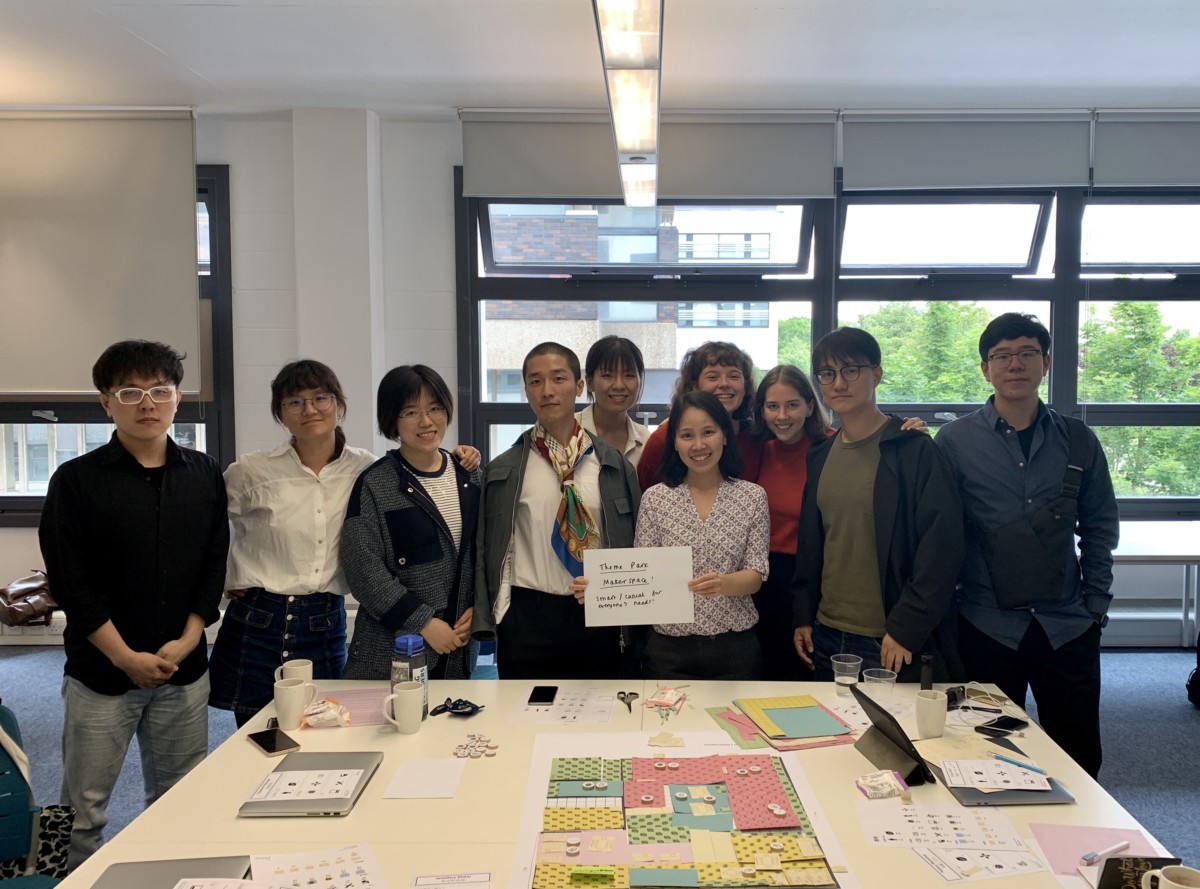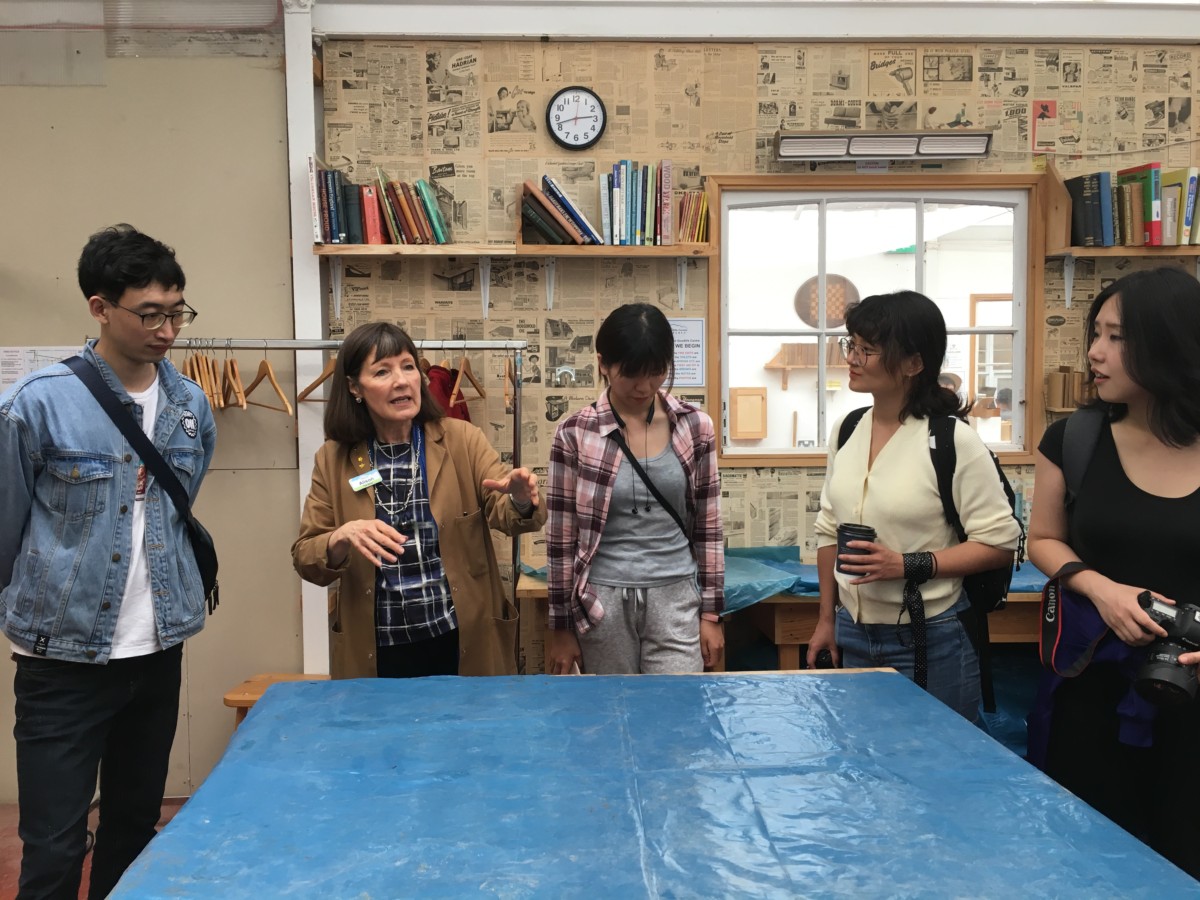Fostering creative citizens through co-design and public makerspaces was a three-year action research project in collaboration with Brunel University London and Tongji University in Shanghai, funded by the Arts and Humanities Research Council and Newton Fund, UK.
Project date: 2018 – 2021
The Story
This project sought to develop a novel and inclusive means of fostering creative citizens in China in a bottom-up manner through strategic use of co-design and public makerspaces. The project produced bilingual resources that shared experience and learning from the UK and China, to help inspire makerspaces of the future.
Key stages of the project
In Year 1, the team focused on identifying good practices of creative communities and find out key requirements regarding public makerspaces in China in order to create suitable strategies. In Year 2, the team developed a prototype of public makerspace in one of the community neighbourhood centres in Shanghai with the intention of scaling up and expanding to other areas in China. The team also initiated community co-design projects between local residents and design students from Tongji University to introduce the co-design process to local communities. The processes and outcomes of community projects were thoroughly evaluated to identify potential impact and key lessons learned were extracted to develop suitable strategies and action plans for scaling up. Year 3 concentrated on developing a strategic design framework and guidelines for developing community creative hubs.
While the study focused on fostering creative citizens in China, a number of research outcomes were created benefit the UK creative economy. The study create numerous opportunities for idea/knowledge exchange between academics and practitioners in the UK and China, and produced bilingual best practice case studies and practical resources for community groups and practitioners in both countries. It also actively engaged with community creative hubs here in the UK.
From a Glass-House perspective, the project allowed us to take our expertise to support community empowerment through the co-design of community hubs in China, and to develop our own networks, learning and resources around communities designing and running local community centres and makerspaces here in the UK.
The Glass-House activity
As well as playing a strategic role in the development and delivery of the project, The Glass-House injected specific activities into the research journey:
CREATING A CO-DESIGN WORKSHOP FOR MAKERSPACES
One of the core approaches in this project was the use of collaborative co-design workshops to bring people together to explore perceptions and ambitions for makerspaces. The Glass-House team took our well-established ‘Design by Consensus’ workshop, and adapted it for use with a range of participants both in the UK and China. This version of our workshop had a clear objective – to help different stakeholders develop empathy for each other and to create shared visions and design ideas for public makerspaces and community creative hubs.
You can read more about the adaptation of this workshop here
SUPPORTING A STUDY VISIT TO THE UK FOR CHINESE ACADEMICS, RESEARCHERS AND MAKERS
The Glass-House team, working with colleagues from Brunel University London, hosted a study visit for our Chinese colleagues in June 2019. Participants took part in a series of visits to UK makerspaces, with the programme culminating in a full-day conference. This event brought our visitors together with researchers, practitioners and makers from the UK to explore the social and economic value created by these creative spaces for co-design and co-production and their impact in communities.
We took our Chinese visitors to the Goodlife Centre near London Bridge, and the Remakery in Loughborough Junction, South London. The Goodlife Centre is a makerspace which offers a wide range of courses from basketry to beginner’s DIY. There are no open workshops or drop in appointments, so all users of the space are there for classes. The centre also offers traditional long-term woodwork apprenticeships, giving students the chance to learn under an expert craftsman.
The Remakery focuses on the reuse of material and upskilling the community, and provides workshop facilities on a time-spent-making tiered system, rents whole spaces, provides workshops and has an area to display objects for sale. The priority here for generating space and creative opportunities for people who walk through their door.
You can read more about this study visit here
At the conference, our research team ran a pilot Design by Consensus: Makerspaces workshop with our Chinese visitors. While delivered in English, the materials and resources we used were highly tactile with limited text, all of which was translated into Mandarin. Working in two groups, we asked participants, who had varying experiences with makerspaces in China, to work in teams to create a vision and design ideas for their ideal makerspace. The workshop revealed some fascinating differences between the two different cultures, but also demonstrated that there are some core driving principles that drive places where people can come together to be creative.
VIST TO SHANGHAI
The following week, the research team, including The Glass-House Chief Executive Sophia, set off for our study visit to China. While there, we worked with colleagues at the College of Design and Innovation at Tongji University in Shanghai to deliver an open event for local people on makerspaces. At this event, we heard from guest speakers about innovative projects happening in China and abroad, and invited participants to take part in the Design by Consensus workshop. This time the workshop was run in Mandarin, and to our great excitement, participants from the group who visited London helped us co-facilitate. We then left the workshop resources and interactive materials with our colleagues at the university, to use with their students and in future public-facing events.
The research team also visited a broad range of spaces for making and creative activities, including neighbourhood-based centres, hackerspaces, and Fablab technology centres in Shanghai, and then Shaji, a Taobao Village in a rural area outside the city. Looking across a spectrum of different types of creative spaces, we were able to see some common threads, and bring home some valuable learning on approaches and principles both shared by and differing from those in the UK.
You can read more about the places we visited and what we learned here.
You can find out more about the whole project in the summary publication or on the Creative Makerspaces website.


Impact
Creating a space for meaningful discussion and debate
While running these workshops, we saw people exploring quite complex and sometimes challenging questions and differences in opinion in a playful and supported way. Points of conflict quite quickly became open conversations exploring motivations, perceptions and moved to negotiating points of consensus and shared ideas and ambitions. The hands-on and creative nature of the activities also allowed people to contribute in different ways, perhaps more quietly, but with similar influence.
Revitalising Glass-House workshops and methods
The work we did on reimagining the Design by Consensus workshop for Makerspaces has had a big impact on our organisation. We had long been mindful of the importance of creating accessible and tactile workshop resources, and the added challenge of making the workshop one that could work in another language and culture, has made us more interested than ever on the sorts of materials we use, and on accessibility.
We also had to think about designing the workshop in such a way that we would be able to hand the workshop over to others to use, without being able to train all of the facilitators who will use it. This has helped us think about ways that we can make our approaches more accessible and available for others to pick up and use, and how best to support others to do what we do in very broad terms. How can we best enable other enablers?
Seeing participants from the first workshop easily stepping in to help facilitate the second, demonstrated that we had made steps in the right direction. The fact the Tongji University staff were also enthusiastic about using it within their design courses felt both encouraging and rewarding. We will be keen to see how it is used further both through this research project and otherwise in China.
Explore
ON OUR BLOG
Co-designing a co-design workshop
IN OUR RESOURCES
Fostering Creative Citizens through co-design and public Makerspaces
The project team has produced a summary publication to capture and share our findings.
Design by Consensus: Makerspaces Facilitation Guide
One of the key The Glass-House contributions to this project was to adapt one of our longstanding workshops, Design by Consensus, to explore the co-design of makerspaces in both China and the UK. Having delivered the workshop in both countries and within a range of settings, we have now produced a facilitation guide to help others deliver this workshop in their own places.
Spaces for Connection: fostering creative citizens through makerspaces in China
This publication draws together learning from a series of visits to creative community spaces in China. Looking at different models, including neighbourhood-based community centres, hackerspaces, Fablab technology centres, and Taobao Villages, we explore the strengths of the different approaches taken, and extract some themes and recommendations to support a spectrum of creative makerspaces and community co-design spaces in the UK.
IN JOURNALS
The research team has also contributed to journals through this research
Co-design visions of public makerspaces in China , in the International Journal of Design Creativity and Innovation discusses the notion of creativity relation to co-design and makerspaces. It explores the critical requirements of co-design and makerspace design, and looks at the cultural differences that emerged through the research project activities using the The Glass-House Design by Consensus: Makerspaces workshop model in both China and the UK.
Fostering creativity through co-design and making: Case studies of makerspaces in the UK, in the Journal of Design Research, discusses how individual creativity can be fostered through co-design activities and the act of making, especially those taking place in makerspaces. Firstly, it explores relationships between creative development, and co-design activities. Secondly, it investigates types of co-design activities occurring in makerspaces. Next, it explores good practices currently employed by different makerspaces across the UK.








